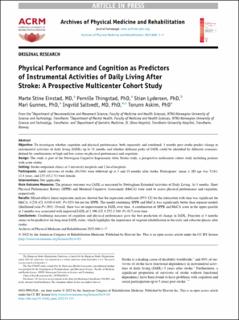| dc.contributor.author | Einstad, Marte Stine | |
| dc.contributor.author | Thingstad, Pernille | |
| dc.contributor.author | Lydersen, Stian | |
| dc.contributor.author | Gunnes, Mari | |
| dc.contributor.author | Saltvedt, Ingvild | |
| dc.contributor.author | Askim, Torunn | |
| dc.date.accessioned | 2023-04-19T06:44:50Z | |
| dc.date.available | 2023-04-19T06:44:50Z | |
| dc.date.created | 2022-09-20T13:40:15Z | |
| dc.date.issued | 2022 | |
| dc.identifier.citation | Archives of Physical Medicine and Rehabilitation. 2022, 103 (7), 1320-1326. | en_US |
| dc.identifier.issn | 0003-9993 | |
| dc.identifier.uri | https://hdl.handle.net/11250/3063688 | |
| dc.description.abstract | Objective: To investigate whether cognition and physical performance, both separately and combined, 3 months post stroke predict change in instrumental activities of daily living (IADL) up to 18 months and whether different paths of IADL could be identified by different scenarios, defined by combinations of high and low scores on physical performance and cognition. Design: The study is part of the Norwegian Cognitive Impairment After Stroke study, a prospective multicenter cohort study including patients with acute stroke. Setting: Stroke outpatient clinics at 3 university hospitals and 2 local hospitals. Participants: Adult survivors of stroke (N=544) were followed up at 3 and 18 months after stroke. Participants’ mean § SD age was 72.6§ 11.8 years, and 235 (43.2 %) were female. Interventions: Not applicable. Main Outcome Measures: The primary outcome was IADL as measured by Nottingham Extended Activities of Daily Living. At 3 months, Short Physical Performance Battery (SPPB) and Montreal Cognitive Assessment (MoCA) were used to assess physical performance and cognition, respectively. Results: Mixed-effects linear regression analyses showed that the regression coefficient (95% CI) for the interaction with time was significant for MoCA, 0.238 (CI, 0.030-0.445; P=.025) but not for SPPB. The model combining SPPB and MoCA was significantly better than separate models (likelihood ratio P<.001). Overall, there was no improvement in IADL over time. A combination of SPPB and MoCA score in the upper quartile at 3 months was associated with improved IADL of 1.396 (CI, 0.252-2.540; P=.017) over time. Conclusions: Combining measures of cognition and physical performance gave the best prediction of change in IADL. Function at 3 months seems to be predictive for long-term IADL status, which highlights the importance of targeted rehabilitation in the early and subacute phases after stroke. | en_US |
| dc.language.iso | eng | en_US |
| dc.publisher | Elsevier | en_US |
| dc.rights | Navngivelse 4.0 Internasjonal | * |
| dc.rights.uri | http://creativecommons.org/licenses/by/4.0/deed.no | * |
| dc.title | Physical Performance and Cognition as Predictors of Instrumental Activities of Daily Living After Stroke: A Prospective Multicenter Cohort Study | en_US |
| dc.title.alternative | Physical Performance and Cognition as Predictors of Instrumental Activities of Daily Living After Stroke: A Prospective Multicenter Cohort Study | en_US |
| dc.type | Journal article | en_US |
| dc.type | Peer reviewed | en_US |
| dc.description.version | publishedVersion | en_US |
| dc.source.pagenumber | 1320-1326 | en_US |
| dc.source.volume | 103 | en_US |
| dc.source.journal | Archives of Physical Medicine and Rehabilitation | en_US |
| dc.source.issue | 7 | en_US |
| dc.identifier.doi | 10.1016/j.apmr.2022.01.153 | |
| dc.identifier.cristin | 2053557 | |
| cristin.ispublished | true | |
| cristin.fulltext | original | |
| cristin.qualitycode | 1 | |

